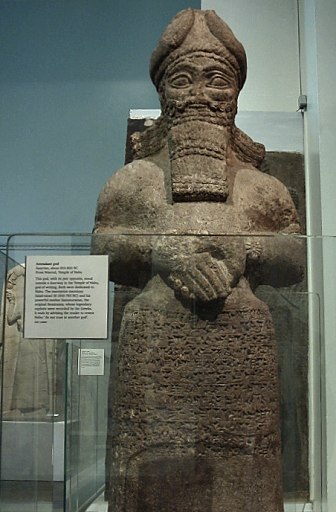
This is one of a pair of statues that stood outside the doorway of the temple of Nabu, god of writing. The cuneiform inscription on it (translation available here) mentions King Adad-Nirari III (810-783 BC), and his powerful mother, queen Sammuramat (Semiramis). The end of the inscription says, "Trust in Nabu, do not trust in any other god". Clasping the hands together over or just below the chest, with the right hand over the left, whilst in a standing position, is very common posture in mesopotamian statues, and I think it is a votive gesture done by worshippers. It is still done today, as part of the Muslim prayer ritual.
This is the first photo I took. The statue is the first thing you see on the right of room 6, the start of the Ancient Near East section on the ground floor of the west wing of the museum. Below is an excerpt from the SDA Bible Commentary that is related to it. It says that the statue is of Nabu, set up by a governor dedicated to the king, but the museum sign said it was of an attendant god and dates it older than in the article below:
A strange religious revolution took place in the time of Adad-nirari III, which can be compared with that of the Egyptian Pharaoh Ikhnaton. For an unknown reason Nabu (Nebo), the god of Borsippa, seems to have been proclaimed sole god, or at least the principal god, of the empire. A Nabu temple was erected in 787 B.C. at Calah, and on a Nabu statue one of the governors dedicated to the king appear the significant words, "Trust in Nabu, do not trust in any other god" The favorite place accorded Nabu in the religious life of Assyria is revealed by the fact that no other god appears so often in personal names. This monotheistic revolution had as short a life as the Aton revolution in Egypt. The worshipers of the Assyrian national deities quickly recovered from their impotence, reoccupied their privileged places, and suppressed Nabu. This is the reason that so little is known concerning the events during the time of the monotheistic revolution. Biblical chronology places Jonah's ministry in the time of Jeroboam II, of Israel, who reigned from 793 to 753 b.c. Hence, Jonah's mission to Nineveh may have occurred in the reign of Adad-nirari III, and may have had something to do with his decision to abandon the old gods and serve only one deity. This explanation can, however, be given only as a possibility, because source material for that period is so scanty and fragmentary that a complete reconstruction of the political and religious history of Assyria during the time under consideration is not yet possible.-- From "The Ancient World From c. 1400 to 586 B.C." in Vol. 2 of: Nichol, Francis D., The Seventh-day Adventist Bible Commentary, (Washington, D.C.: Review and Herald Publishing Association) 1978.